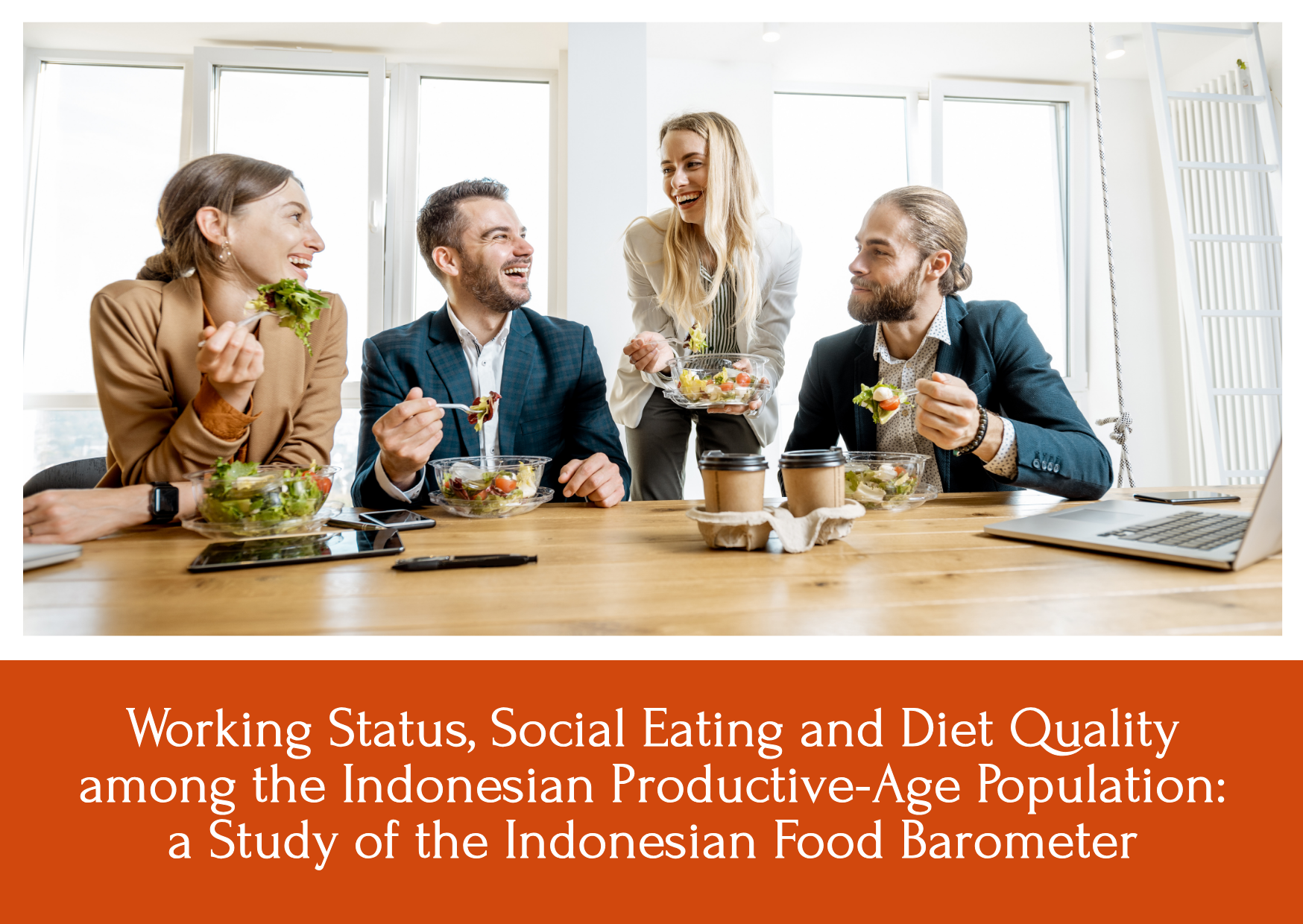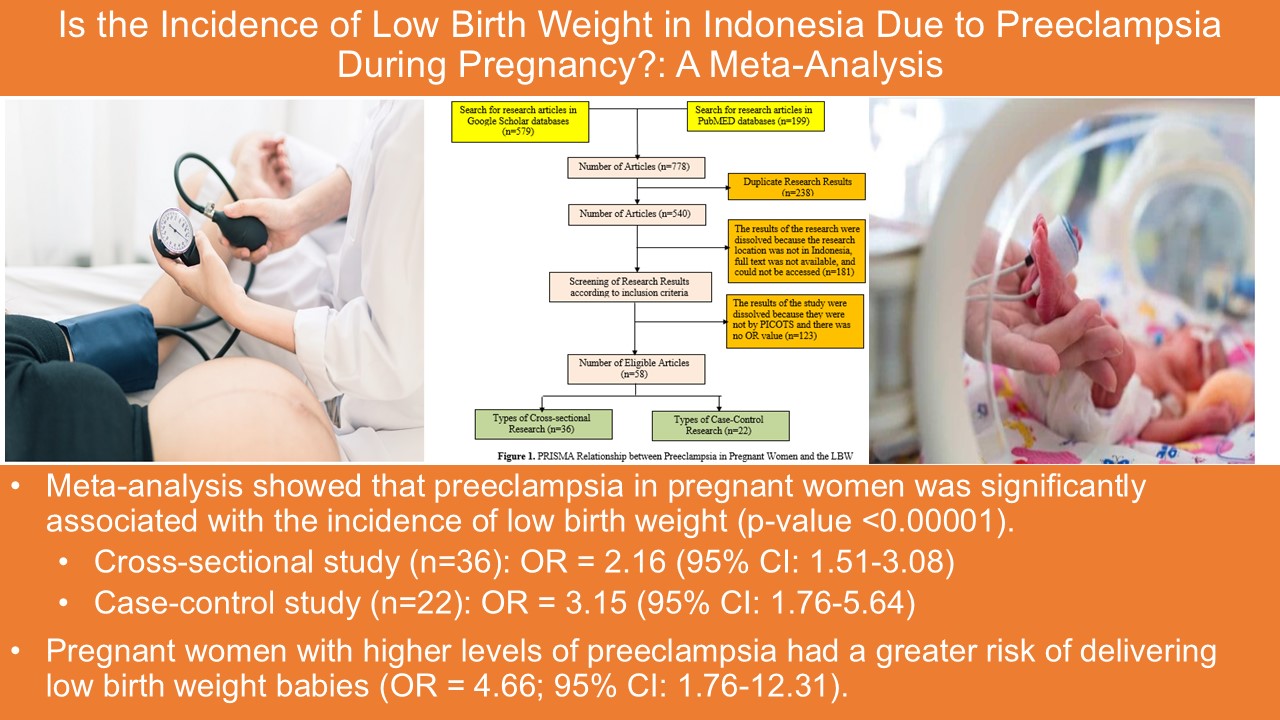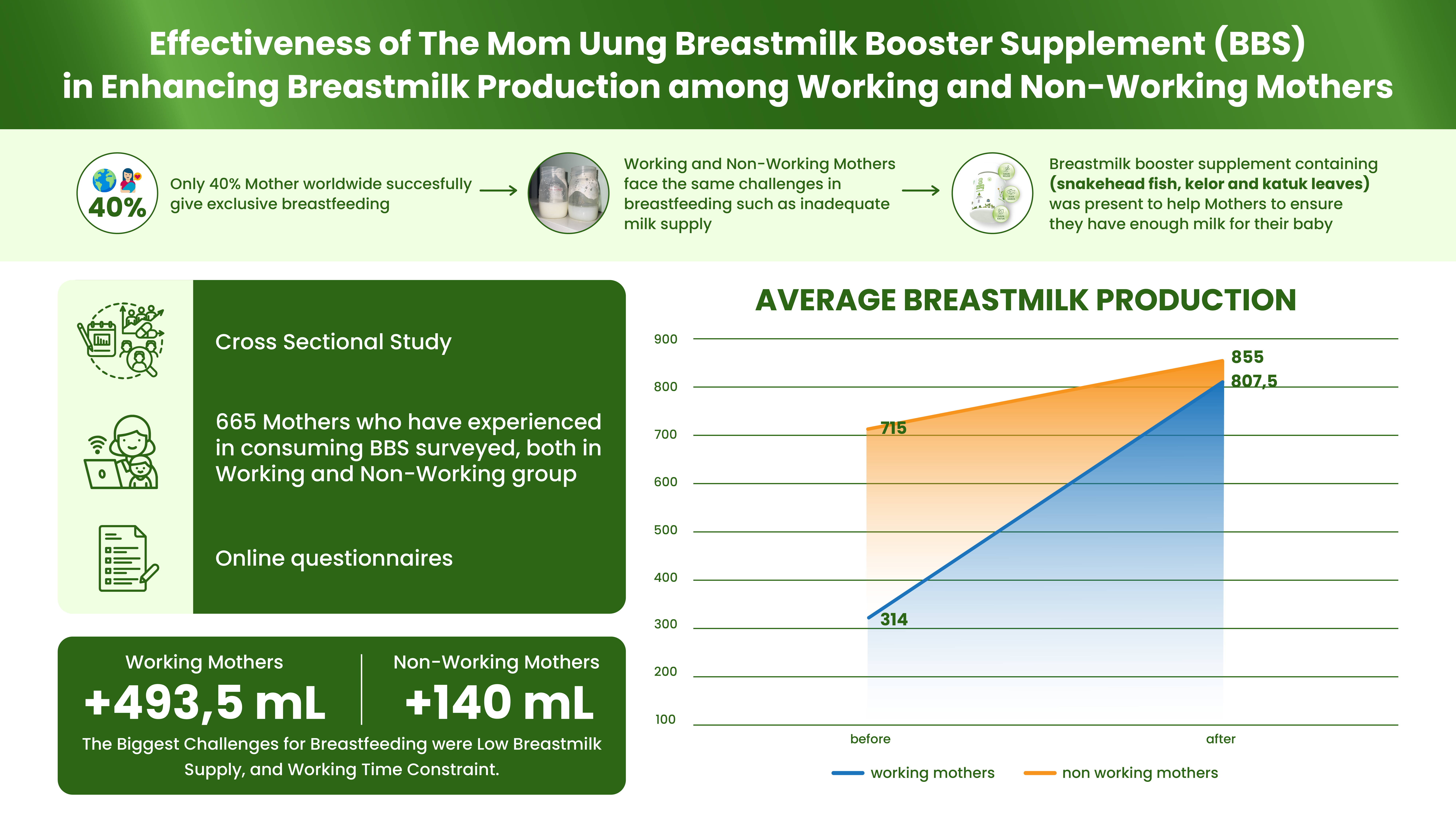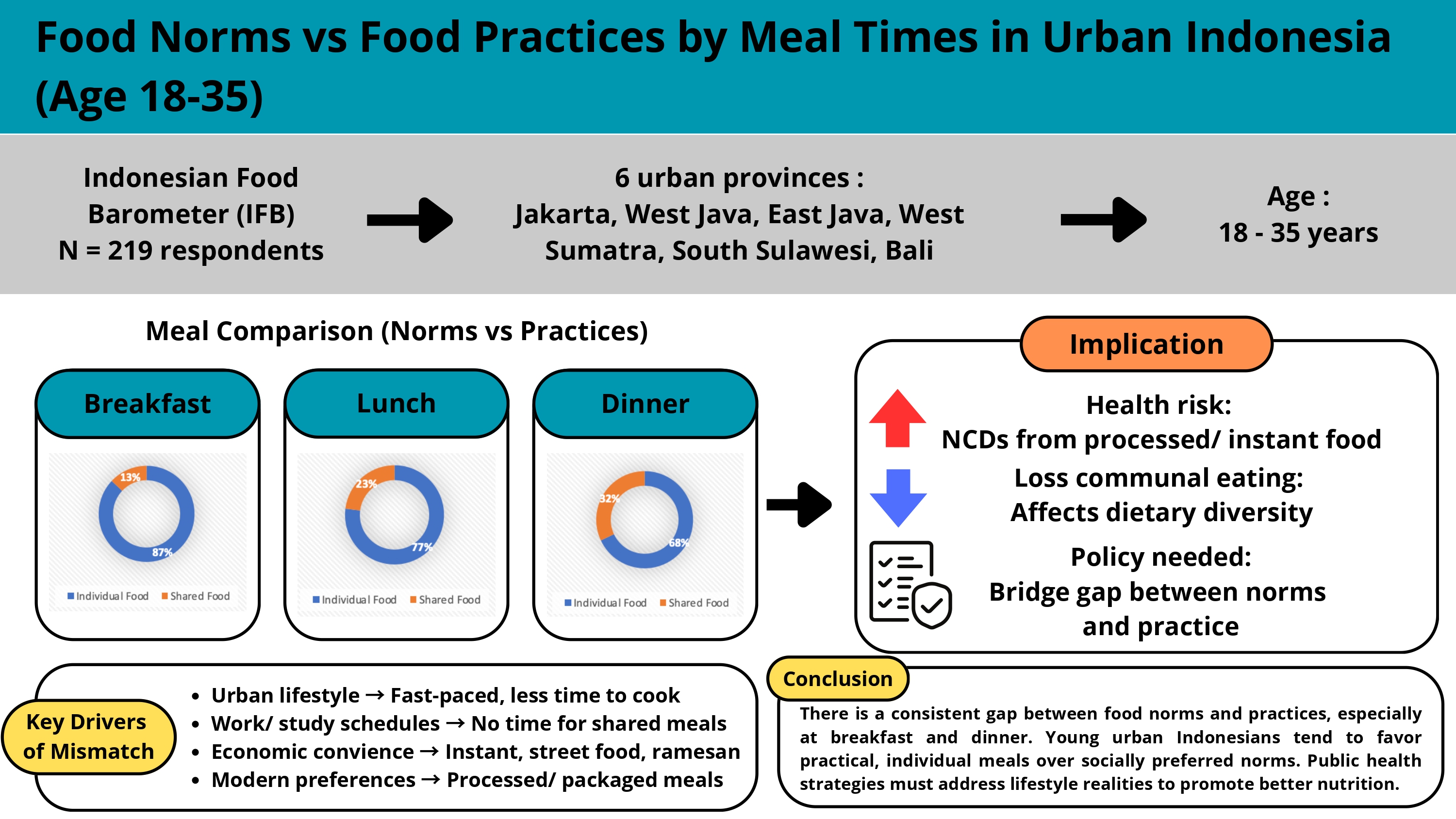WORKING STATUS, SOCIAL EATING AND DIET QUALITY AMONG THE INDONESIAN PRODUCTIVE-AGE POPULATION: A STUDY OF THE INDONESIAN FOOD BAROMETER

Downloads
The 2014 Total Diet Study reported that the dietary patterns among Indonesians remain inconsistent with the 2014 Balanced Nutrition Guidelines. Employment status is known to influence social eating behaviors, and social eating during lunch may affect diet quality. This study aims to determine the relationship between employment status and social eating with diet quality among the productive-age population in Indonesia as measured by the Balanced Nutrition Index. This study employed a cross-sectional approach using secondary data from the 2018 Indonesian Food Barometer, with a sample of 271 respondents (135 men and 136 women) who met the inclusion criteria. The variables analyzed in this study were respondent characteristics, employment status, and social eating. Chi-squared test revealed that employment status and social eating had no significant relationship with diet quality. However, socioeconomic status had a relationship with diet quality (p = 0.026). Multivariate analysis further revealed that socioeconomic status was a dominant factor in diet quality among the productive-age population in Indonesia. Individuals with low socioeconomic status faced a 2.5-times higher risk of poor diet quality compared to those with high socioeconomic status.
Abassi, M. M., Sassi, S., El Ati, J., Ben Gharbia, H., Delpeuch, F., & Traissac, P. (2019). Gender inequalities in diet quality and their socioeconomic patterning in a nutrition transition context in the Middle East and North Africa: A cross-sectional study in Tunisia. Nutrition Journal, 18(1).
Aigner, A., Becher, H., Jacobs, S., Wilkens, L. R., Boushey, C. J., Le Marchand, L., Haiman, C. A., & Maskarinec, G. (2018). Low diet quality and the risk of stroke mortality: the multiethnic cohort study. European Journal of Clinical Nutrition, 72(7), 1035–1045.
Al-Faida, N. (2021). Pengaruh kebiasaan sarapan terhadap konsentrasi belajar mahasiswa stikes persada nabire provinsi papua. Ikesma, 17(2), 81.
Alkerwi, A. (2014). Diet quality concept. Nutrition, 30(6), 613–618.
Amrin, A. P., Hardinsyah, H., & Dwiriani, C. M. (2013). Alternatif indeks gizi seimbang untuk penilaian mutu gizi konsumsi pangan pria dewasa Indonesia. Jurnal Gizi dan Pangan, 8(3), 167-176.
Assumpção, D. de, Senicato, C., Fisberg, R. M., Canesqui, A. M., & Barros, M. B. de A. (2018). Are there differences in the quality of the diet of working and stay-at-home women? Revista de Saude Publica, 52, 47.
Atmarita, A., Jahari, A. B., Sudikno, S., & Soekatri, M. (2016). Asupan gula, garam, dan lemak di Indonesia: Analisis survei konsumsi makanan individu (SKMI) 2014. Gizi Indonesia, 39(1), 1–14.
Aune, D., Keum, N., Giovannucci, E., Fadnes, L. T., Boffetta, P., Greenwood, D. C., Tonstad, S., Vatten, L. J., Riboli, E., & Norat, T. (2018). Dietary intake and blood concentrations of antioxidants and the risk of cardiovascular disease, total cancer, and all-cause mortality: a systematic review and dose-response meta-analysis of prospective studies. The American Journal of Clinical Nutrition, 108(5), 1069–1091.
Avery, A., Anderson, C., & McCullough, F. (2017). Associations between children's diet quality and watching television during meal or snack consumption: A systematic review. Maternal & Child Nutrition, 13(4), e12428.
Chae, W., Ju, Y. J., Shin, J., Jang, S.-I., & Park, E.-C. (2018). Association between eating behaviour and diet quality: eating alone vs. eating with others. Nutrition Journal, 17(1), 1–11.
Christy, S., Khusun, H., Chandra, D. N., & Sunardi, D. (2021). Nutrition fact panel use and its association to diet quality among University students in Universitas Indonesia. Jurnal Gizi Dan Pangan, 16(3), 139–148.
Darmon, N., & Drewnowski, A. (2008). Does social class predict diet quality?. The American Journal of Clinical Nutrition, 87(5), 1107-1117.
Fariski, C., Dieny, F. F., & Wijayanti, H. S. (2020). Kualitas Diet, Status Gizi Dan Status Anemia Wanita Prakonsepsi Antara Desa Dan Kota. Gizi Indonesia, 43(1), 11–24.
Febriana, N. L., Februhartanty, J., Hanisa, N., & Khusun, H. (2024). Eating behavior of Indonesian adults differ by metropolization levels based on the 2018 Indonesian food barometer. National Nutrition Journal/Media Gizi Indonesia, 19(1).
Febriani, S., Hendrarini, H., & Atasa, D. (2023). Pola Konsumsi Food Away from Home (FAFH) Masyarakat Kota Surabaya. Jurnal Bisnis Dan Manajemen, 3(5), 1017–1025.
Fernandez, M. A., Marquis, M., Desroches, S., Turcotte, M., & Provencher, V. (2019). Full-time employment, diet quality, and food skills of Canadian parents. Canadian Journal of Dietetic Practice and Research, 80(2), 63-71.
Fleet, K., Lengyel, C., Urquia, M. L., Clara, I., & Eck, P. (2023). Factors that influence diet quality in adult populations: A scoping review. International Journal of Public Health, 15(2), 133–155.
French, S. A., Tangney, C. C., Crane, M. M., Wang, Y., & Appelhans, B. M. (2019). Nutrition quality of food purchases varies by household income: The SHoPPER study. BMC Public Health, 19(1).
Gao, X., Engeda, J., Moore, L. V., Auchincloss, A. H., Moore, K., & Mujahid, M. S. (2022). Longitudinal associations between objective and perceived healthy food environment and diet: The Multi-Ethnic Study of Atherosclerosis. Social Science and Medicine, 292.
Gardiarini, P., Dianovita, C., & Farida, F. (2024). Pengaruh frekuensi menonton drama korea, kebiasan makan, dan pendidikan terhadap kualitas diet dan status gizi mahasiswa Politeknik Negeri Balikpapan. Jurnal SAGO Gizi Dan Kesehatan, 5(2), 409–418.
Gorgulho, B. M., Fisberg, R. M., & Marchioni, D. M. L. (2013). Nutritional quality of major meals consumed away from home in Brazil and its association with the overall diet quality. Preventive Medicine, 57(2), 98–101.
Grech, A., Sui, Z., Siu, H. Y., Zheng, M., Allman-Farinelli, M., & Rangan, A. (2017). Socio-demographic determinants of diet quality in Australian adults using the validated healthy eating index for Australian adults (HEIFA-2013). Healthcare (Switzerland), 5(1).
Havelaar, S. G., Khusun, H., Chandra, D. N., & Bardosono, S. (2023). Lifestyle, Mental Health and Quality of Life Among Obese Women during COVID-19 Pandemic in DKI Jakarta. International Conference on Health and Well-Being (ICHWB 2022), 153–161.
Higgs, S., & Thomas, J. (2016). Social influences on eating. Current Opinion in Behavioral Sciences, 9, 1–6.
Hiza, H. A. B., Casavale, K. O., Guenther, P. M., & Davis, C. A. (2013). Diet quality of Americans differs by age, sex, race/ethnicity, income, and education level. Journal of the Academy of Nutrition and Dietetics, 113(2), 297–306.
Holm, L., Lund, T. B., & Niva, M. (2015). Eating practices and diet quality: a population study of four Nordic countries. European Journal of Clinical Nutrition, 69(7), 791–798.
Kang, M., Park, S.-Y., Shvetsov, Y. B., Wilkens, L. R., Le Marchand, L., Boushey, C. J., & Paik, H.-Y. (2019). Sex differences in sociodemographic and lifestyle factors associated with diet quality in a multiethnic population. Nutrition, 66, 147–152.
Khusun, H., Anggraini, R., Februhartanty, J., Mognard, E., Fauzia, K., Maulida, N. R., Linda, O., & Poulain, J.-P. (2023). Breakfast consumption and quality of macro-and micronutrient intake in Indonesia: a study from the Indonesian food barometer. Nutrients, 15(17), 3792.
Livingstone, K. M., Olstad, D. L., Leech, R. M., Ball, K., Meertens, B., Potter, J., Cleanthous, X., Reynolds, R., & McNaughton, S. A. (2017). Socioeconomic inequities in diet quality and nutrient intakes among Australian adults: Findings from a nationally representative cross-sectional study. Nutrients, 9(10).
Mancino, L., Todd, J., & Lin, B.-H. (2009). Separating what we eat from where: measuring the effect of food away from home on diet quality. Food Policy, 34(6), 557–562.
Martin, J. C., Moran, L. J., Teede, H. J., Ranasinha, S., Lombard, C. B., & Harrison, C. L. (2017). Exploring diet quality between urban and rural dwelling women of reproductive age. Nutrients, 9(6), 586.
McCullough, M. L., Chantaprasopsuk, S., Islami, F., Rees-Punia, E., Um, C. Y., Wang, Y., Leach, C. R., Sullivan, K. R., & Patel, A. V. (2022). Association of socioeconomic and geographic factors with diet quality in US adults. JAMA Network Open, 5(6), e2216406-e2216406.
Mohammadifard, N., Talaei, M., Sadeghi, M., Oveisegharan, S., Golshahi, J., Esmaillzadeh, A., & Sarrafzadegan, N. (2017). Dietary patterns and mortality from cardiovascular disease: Isfahan Cohort Study. European Journal of Clinical Nutrition, 71(2), 252–258.
Molendijk, M., Molero, P., Sánchez-Pedreño, F. O., Van der Does, W., & Martínez-González, M. A. (2018). Diet quality and depression risk: a systematic review and dose-response meta-analysis of prospective studies. Journal of Affective Disorders, 226, 346–354.
Morze, J., Danielewicz, A., Hoffmann, G., & Schwingshackl, L. (2020). Diet quality as assessed by the healthy eating index, alternate healthy eating index, dietary approaches to stop hypertension score, and health outcomes: a second update of a systematic review and meta-analysis of cohort studies. Journal of the Academy of Nutrition and Dietetics, 120(12), 1998–2031.
Muslihah, N., Ariestiningsih, A. D., Almirra, I. R., & Ginting, A. T. (2022). Nutritional Status and its Associations with Eating Behavior and Diet Quality among Adult: A Cross-Sectional Study. Open Access Macedonian Journal of Medical Sciences, 10(T8), 167–173.
Nurpratama, W. L., Briawan, D., & Riyadina, W. (2022). Faktor Perubahan Kualitas Diet dengan Indonesia Healthy Eating Index pada Penderita PJK. Indonesian Journal of Human Nutrition, 9(2), 193.
Pachucki, M. C., Karter, A. J., Adler, N. E., Moffet, H. H., Warton, E. M., Schillinger, D., O’Connell, B. H., & Laraia, B. (2018). Eating with others and meal location are differentially associated with nutrient intake by sex: The Diabetes Study of Northern California (DISTANCE). Appetite, 127, 203–213.
Paludi, S., & Juwita, R. (2021). Pengaruh Persepsi Harga, Lokasi Dan Kualitas Produk Terhadap Keputusan Pembelian. Equilibrium: Jurnal Penelitian Pendidikan Dan Ekonomi, 18(01), 41–53.
Palupi, N. S., Chandra, D. N., Februhartanty, J., Khusun, H., Hanisa, N., & Dewi, D. K. (2024). Nutrient-rich food index 9.3 score and food choice values among female online food delivery users during COVID-19 pandemic. World Nutrition Journal, 7(i2), 65–77.
Panizza, C. E., Wong, M. C., Kelly, N., Liu, Y. E., Shvetsov, Y. B., Lowe, D. A., Weiss, E. J., Heymsfield, S. B., Kennedy, S., & Boushey, C. J. (2020). Diet quality and visceral adiposity among a multiethnic population of young, middle, and older aged adults. Current Developments in Nutrition, 4(6), nzaa090.
Pestoni, G., Krieger, J. P., Sych, J. M., Faeh, D., & Rohrmann, S. (2019). Cultural differences in diet and determinants of diet quality in Switzerland: Results from the national nutrition survey menuch. Nutrients, 11(1).
Pimenta, P., Lopes, C. M. M., Correia, D. M., Torres, D. P. M., Rodrigues, S. S. P., & Vilela, S. (2022). Interaction effects of socio-economic position in the association between eating location and diet quality in Portuguese children and adolescents: results from the National Food, Nutrition and Physical Activity Survey 2015–2016. British Journal of Nutrition, 128(5), 940–947.
Poulain, J.-P., Laporte, C., Tibère, L., Mognard, E., Ragavan, N. A., Zadeh, A. A., & Noor, I. M. (2020). Malaysian Food Barometer (MFB): a study of the impact of compressed modernisation on food habits. Malaysian Journal of Nutrition, 26(1).
Rahmasari, N. A., Chandra, D. N., & Khusun, H. (2022). Food Choice Motives among Workers during COVID-19 Pandemic in Jakarta. Amerta Nutrition, 6(2).
Rahmawati, R., Hardinsyah, H., & Roosita, K. (2015). Pengembangan indeks gizi seimbang untuk menilai kualitas gizi konsumsi pangan remaja (13-15 tahun) di Indonesia. Media Kesehatan Masyarakat Indonesia, 11(3), 160–167.
Rahmazahra Danty, F., Nur Hasan Syah, M., Eka Sari, A., Studi, P. S., Gizi STIKes Mitra Keluarga Bekasi Timur Jl Pengasinan, I., Semut, R., & Timur, B. (2019). Hubungan Indeks Gizi Seimbang dengan Status Gizi Pada Remaja Putri di SMK Kota Bekasi. The Indonesian Journal of Health1.
Ranjit, N., Macias, S., & Hoelscher, D. (2020). Factors related to poor diet quality in food insecure populations. Translational Behavioral Medicine, 10(6), 1297-1305.
Ri, K. (2018). Hasil Utama Riset Kesehatan Dasar. Jakarta: Kementerian Kesehatan Re-Publik Indonesia.
Rodhiah, W. S., Chandra, D. N., & Khusun, H. (2023). Association between social eating and diet quality among adult. Jurnal Kesehatan Tambusai, 4(3), 4337-4345.
Rozjabek, H., Fastenau, J., LaPrade, A., & Sternbach, N. (2020). Adult obesity and health-related quality of life, patient activation, work productivity, and weight loss behaviors in the United States. Diabetes, Metabolic Syndrome and Obesity, Targets and Therapy, 13, 2049–2055.
Sakai, H., Murakami, K., Kobayashi, S., Suga, H., & Sasaki, S. (2017). Food-based diet quality score in relation to depressive symptoms in young and middle-aged Japanese women. British Journal of Nutrition, 117(12), 1674–1681.
Sartika, A. N. (2018). Association of Eating Behaviour and Diet Quality Among Adults Living in Urban and Rural Area of East Java. Universitas Indonesia.
Sekarini, A. G. A., Fitranti, D. Y., Tsani, A., & Noer, E. R. (2022). Hubungan Emotional Eating dan Kualitas Diet dengan Kenaikan Berat Badan pada Mahasiswi saat Pandemi Covid-19. Amerta Nutrition, 5(3).
Shams-White, M. M., Korycinski, R. W., Dodd, K. W., Barrett, B., Jacobs, S., Subar, A. F., Park, Y., & Bowles, H. R. (2021). Examining the association between meal context and diet quality: an observational study of meal context in older adults. International Journal of Behavioral Nutrition and Physical Activity, 18(1).
Siswanto, P. D., Lamid, A., Prihatini, S., & Rosmalina, Y. (2014). Buku Survei Konsumsi Makanan Individu dalam Studi Diet Total 2014. Jakarta: Lembaga Penerbitan Badan Litbangkes.
Sobal, J., & Nelson, M. K. (2003). Commensal eating patterns: a community study. Appetite, 41(2), 181–190.
Stefani, S., Ngatidjan, S., Paotiana, M., Sitompul, K. A., Abdullah, M., Sulistianingsih, D. P., Shankar, A. H., & Agustina, R. (2018). Dietary quality of predominantly traditional diets is associated with blood glucose profiles, but not with total fecal Bifidobacterium in Indonesian women. PloS One, 13(12), e0208815.
Swinburn, B. A., Kraak, V. I., Allender, S., Atkins, V. J., Baker, P. I., Bogard, J. R., Brinsden, H., Calvillo, A., De Schutter, O., & Devarajan, R. (2019). The global syndemic of obesity, undernutrition, and climate change: the Lancet Commission report. The Lancet, 393(10173), 791–846.
Thorpe, M. G., Kestin, M., Riddell, L. J., Keast, R. S. J., & McNaughton, S. A. (2014). Diet quality in young adults and its association with food-related behaviours. Public Health Nutrition, 17(8), 1767–1775.
Thorpe, M. G., Milte, C. M., Crawford, D., & McNaughton, S. A. (2019). Education and lifestyle predict change in dietary patterns and diet quality of adults 55 years and over. Nutrition Journal, 18(1).
Tiwari, A., Aggarwal, A., Tang, W., & Drewnowski, A. (2017). Cooking at home: a strategy to comply with US dietary guidelines at no extra cost. American Journal of Preventive Medicine, 52(5), 616–624.
Todd, J. E., Mancino, L., & Lin, B.-H. (2010). The impact of food away from home on adult diet quality. USDA-ERS Economic Research Report Paper, 90.
Triatmoko, B., Chandra, D. N., & Khusun, H. (2024). Comparison of diet quality on weekdays and weekends among high school students in a semi-military education system. World Nutrition Journal, 8(S1), 30.
Yunita, U. R., Khusun, H., & Witjaksono, F. (2024). The association between knowledge and attitude towards nutrition fact panels (NFP) with sugar intake of the Indonesian adolescents. World Nutrition Journal, 7(i2), 54–64.
Zhang, B., Pu, L., Zhao, T., Wang, L., Shu, C., Xu, S., Sun, J., Zhang, R., & Han, L. (2023). Global burden of cardiovascular disease from 1990 to 2019 attributable to dietary factors. The Journal of Nutrition, 153(6), 1730–1741.
Zhang, Y., Ritzel, C., Mognard, E., Mognard, E., Naidoo, K., Laporte, C., Tibère, L., Alem, Y., Khusun, H., & Februhartanty, J. (2023). “Eating Out”, spatiality, temporality and sociality. A database for China, Indonesia, Japan, Malaysia, Singapore and France.

This work is licensed under a Creative Commons Attribution-NonCommercial-ShareAlike 4.0 International License.
- MEDIA GIZI INDONESIA Journal is the copyright owner of all materials published on this website.
- The formal legal provisions for access to digital articles of this electronic journal are subject to the terms of the Creative Commons Attribution-NonCommercial-ShareAlike license (CC BY-NC-SA 4.0), which means that MEDIA GIZI INDONESIA Journal and readers reserve the right to save, transmit media / format, manage in database, maintain, and publish articles as long as it continues to include the name of the Author.
- Printed and published print and electronic manuscripts are open access for educational, research and library purposes. In addition to these objectives, the editorial board shall not be liable for violations of copyright law.


2.png)





















